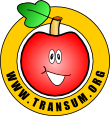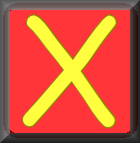
 |
Pandigital NumbersAn exercise exploring the properties of nine-digit numbers containing each of the digits 1 to 9. |
For the purposes of this exercise pandigital numbers are nine digit numbers containing the digits one to nine. Here is an example:
312987456
You can earn a trophy if you get at least 4 questions correct and you do this activity online.
InstructionsTry your best to answer the questions above. Type your answers into the boxes provided leaving no spaces. As you work through the exercise regularly click the "check" button. If you have any wrong answers, do your best to do corrections but if there is anything you don't understand, please ask your teacher for help. When you have got all of the questions correct you may want to print out this page and paste it into your exercise book. If you keep your work in an ePortfolio you could take a screen shot of your answers and paste that into your Maths file. |
||
|
|
||
|
|

|
More Activities: |
|
Mathematicians are not the people who find Maths easy; they are the people who enjoy how mystifying, puzzling and hard it is. Are you a mathematician? Comment recorded on the 2 April 'Starter of the Day' page by Mrs Wilshaw, Dunsten Collage,Essex: "This website was brilliant. My class and I really enjoy doing the activites." Comment recorded on the 28 May 'Starter of the Day' page by L Smith, Colwyn Bay: "An absolutely brilliant resource. Only recently been discovered but is used daily with all my classes. It is particularly useful when things can be saved for further use. Thank you!" |
Each month a newsletter is published containing details of the new additions to the Transum website and a new puzzle of the month. The newsletter is then duplicated as a podcast which is available on the major delivery networks. You can listen to the podcast while you are commuting, exercising or relaxing. Transum breaking news is available on Twitter @Transum and if that's not enough there is also a Transum Facebook page. |
|
AnswersThere are answers to this exercise but they are available in this space to teachers, tutors and parents who have logged in to their Transum subscription on this computer. A Transum subscription unlocks the answers to the online exercises, quizzes and puzzles. It also provides the teacher with access to quality external links on each of the Transum Topic pages and the facility to add to the collection themselves. Subscribers can manage class lists, lesson plans and assessment data in the Class Admin application and have access to reports of the Transum Trophies earned by class members. If you would like to enjoy ad-free access to the thousands of Transum resources, receive our monthly newsletter, unlock the printable worksheets and see our Maths Lesson Finishers then sign up for a subscription now: Subscribe |
||
Go MathsLearning and understanding Mathematics, at every level, requires learner engagement. Mathematics is not a spectator sport. Sometimes traditional teaching fails to actively involve students. One way to address the problem is through the use of interactive activities and this web site provides many of those. The Go Maths page is an alphabetical list of free activities designed for students in Secondary/High school. Maths MapAre you looking for something specific? An exercise to supplement the topic you are studying at school at the moment perhaps. Navigate using our Maths Map to find exercises, puzzles and Maths lesson starters grouped by topic. | ||
Teachers | ||
|
If you found this activity useful don't forget to record it in your scheme of work or learning management system. The short URL, ready to be copied and pasted, is as follows: |
Alternatively, if you use Google Classroom, all you have to do is click on the green icon below in order to add this activity to one of your classes. |
It may be worth remembering that if Transum.org should go offline for whatever reason, there is a mirror site at Transum.info that contains most of the resources that are available here on Transum.org. When planning to use technology in your lesson always have a plan B! |
|
|
||
© Transum Mathematics 1997-2025
Scan the QR code below to visit the online version of this activity.
https://www.Transum.org/go/?Num=763
Close

Divisibility Test - Quick ways to spot whether a number is divisible by the numbers 2 to 9.
Level 1 - Basic questions about pandigital numbers
Level 2 - More challenging questions about pandigital numbers
Level 3 - Excruciatingly difficult questions about pandigital numbers
Magic Square - Each row, column and diagonal should produce the same sum.
Nine Digits - Arrange the given digits to make three numbers such that two of them add up to the third.
Double Treble - Arrange the digits to make three 3 digit numbers such that the second is double the first and the third is three times the first.
Triside Totals - Arrange the given digits to make three numbers such that the third is the product of the first and the second.
Delightfully Divisible - Arrange the digits one to nine to make a number which is divisible in the way described.
Divisive - Arrange the digits one to nine on the spaces provided to make two division calculations containing multiples of three.
Go Figure - Arrange the digits one to nine to make the four calculations correct.
Olympic Rings - Place the digits one to nine in each of the regions created by the Olympic rings so that the sum of the numbers in each ring is the same.
Nine Nine Nine - Use the digits 1 to 9 to make three 3 digit numbers which add up to 999.
Multitude - Arrange the given digits to make three numbers such that the third is the product of the first and the second.
Satisfy - Place the nine numbers in the table so they obey the row and column headings about the properties of the numbers.
The Miller's Puzzle - This is an interactive version of the puzzle described by Henry Ernest Dudeney in The Canterbury Puzzles.
Ludicross - Arrange the given numbers on the cross so that the sum of the numbers in both diagonals is the same.
Largest Product - Drag the numbers and multiplication signs onto the shelf to create the largest possible product.
Centexpression - Drag all of the numbers and some of the symbols onto the shelf to create a calculation for 100.
Suko Sujiko - Interactive number-based logic puzzles similar to those featuring in daily newspapers.
More puzzles including lesson Starters, investigations and self-marking exercises.
The definition of a pandigital number used in this exercise is a nine digit number containing each of the digits one to nine. Other definitions include the digit zero and allow multiple occurances of digits in longer numbers.
Here are some draggable number tiles you may find useful when thinking about pandigital numbers.
1
2
3
4
5
6
7
8
9
Don't wait until you have finished the exercise before you click on the 'Check' button. Click it often as you work through the questions to see if you are answering them correctly. You can double-click the 'Check' button to make it float at the bottom of your screen.
Answers to this exercise are available lower down this page when you are logged in to your Transum account. If you don’t yet have a Transum subscription one can be very quickly set up if you are a teacher, tutor or parent.
Close
